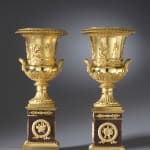Pierre-Philippe Thomire French, 1731-1843
Literature
Hans Ottomeyer and Peter Pröschel, "Vergoldete Bronzen", 1986, p. 362, pl. 5.12.3, illustrating a gilt and patinated bronze vase inspired by the Borghese Vase, of similar form as here and with related female masks in place of the handles by Pierre-Philippe Thomire, stamped Thomire à Paris in the Museum für Kunsthandwerk, Budapest.
A superb pair of Empire gilt bronze and red marble vases by Pierre-Philippe Thomire and stamped THOMIRE A PARIS, each of krater form with a beaded and egg and dart rim above a cast grapevine border interspersed by rosettes, the body cast with mythological scenes showing on one side a classical maiden, most probably Venus half kneeling as she plays a lyre beside the standing figure of Cupid with bow and on the other side with Psyche with butterfly wings seated and holding a pitcher beside Cupid who plays a double flute, the scenes flanked by a ribbon-tied torchère above a beautiful female mask headed reeded handle, the lower body cast with an acanthus and anthemion band on a gadrooned and spreading fluted foot with laurel cast ring, set on a square red marble plinth cast with gilt bronze ribbon-tied wreaths encircling cymbals and pipes alternating with an arrow and pitcher
Paris, date circa 1810
Height 55 cm. each.
This magnificent pair of vases by the finest Empire bronzier Pierre-Philippe Thomire (1751-1843) is clearly inspired by vases from Antiquity most notably the ancient Greek marble Kraters known as the Medici and Borghese Vases. Since the seventeenth century these two were considered the finest of all antique vases and were frequently copied though here the artist has only been loosely inspired by their overall design and certain individual details. Both the Medici and Borghese Vases have similar decoration around the rim above a similar grapevine frieze, likewise they both had reeded handles but with grotesque rather than beautiful female head masks. Again the base of the vase with acanthus and anthemion casting is similar to both antique vases as is the gadrooned and fluted decoration to the foot. The main difference here is the subject on the upper part of the vase, which on the Borghese Vase portrays ecstatic Bacchic revellers accompanying a drunken Silenius while the Medici Vase represents Iphigenia crouching below a statue of Diana with Achilles, Ulysses and Agamemnon to her right. Both the Borghese and Medici Vases date from the 1st century A.D. and are ascribed to Phidias.
By the sixteenth century the later was in the Villa Medici, Rome. It was removed to Florence in 1780 and soon after displayed in the Uffizi, where it remains today. The Borghese Vase was rediscovered in a garden during the late sixteenth century and by 1645 was placed in the Villa Borghese. On 27th September 1807 Napoleon Bonaparte, brother-in-law of Prince Camillo Borghese, purchased it, together with the bulk of the Borghese antiquities. The vase was sent to Paris after 1808 and by l811 was placed on display in the Musée Napoleon.
Here the scenes and accompanying ornament on the plinth all allude to the subject of love. On one side we see Cupid, god of love and his lover Psyche, with her distinctive butterfly wings and on the other side what appears to be Venus playing music to the young god. Various attributes or symbols associated with love appear in the guise of the bow and arrow, the torchères symbolising burning love while music itself has also been long associated with love not only since lovers are often serenaded by music but also on account of the phallic quality of the various pipe instruments - a significance that has been widely recognised since antiquity.



